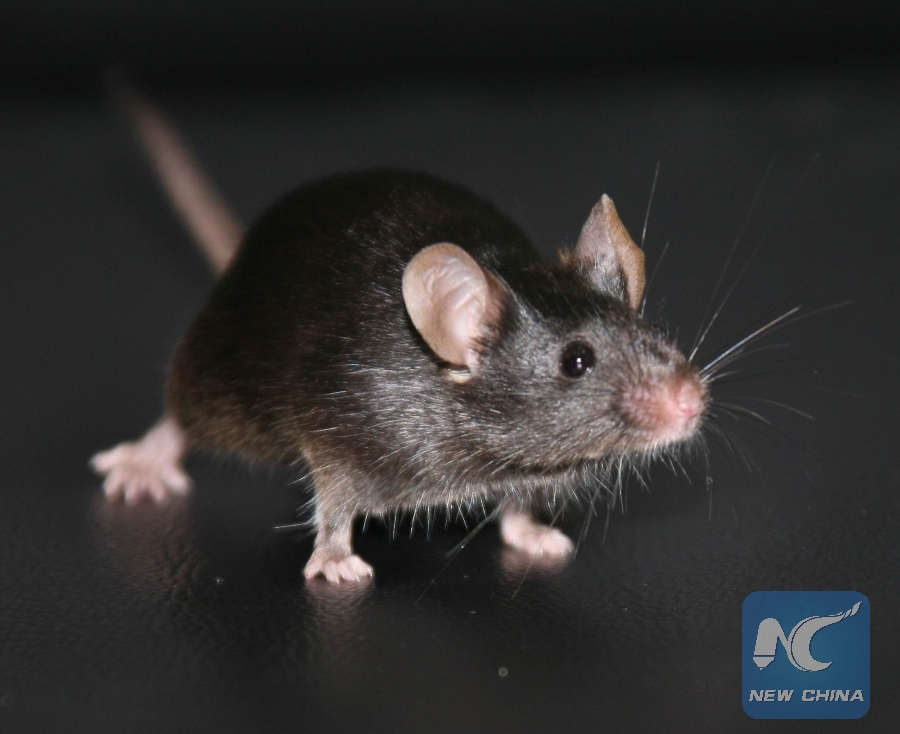
This undated photo provided by animal clone scientist Zhou Qi of the Institute of Zoology in Beijing shows the mouse Xiao Xiao or "Tiny" from the induced pluripotent stem (IPS) cells in its three-month old. Two teams of Chinese researchers have created live mice from IPS cells, answering a lingering question about the developmental potential of the cells, according to a press release published online by Nature on July 23, 2009. (Xinhua/Zhou Qi)
SAN FRANCISCO, Jan. 14 (Xinhua) -- Researchers with the University of California, Berkeley, have found a way to reprogram mouse embryonic stem cells so that they exhibit developmental characteristics resembling those of fertilized eggs, or zygotes.
A fertilized egg is thought to possess full developmental potential, able to generate all cell types required for embryo gestation, including the developing embryo and its extra-embryonic tissues. A unique feature of placental mammals, extra-embryonic tissues such as the placenta and yolk sac are vital for nutrient and waste exchange between the fetus and mother.
By contrast, most embryonic and induced pluripotent stem cells are more restricted in their developmental potential, able to form embryonic cell types, but not extra-embryonic tissues. The ability of a fertilized egg to generate both embryonic and extra-embryonic tissues is referred to as "totipotency," an ultimate stem cell state seen only during the earliest stages of embryonic development.
The "totipotent-like" stem cells created by UC Berkeley researchers, who reported their work this week in the journal Science, are able to generate not only all cell types within a developing embryo, but also cell types that facilitate nutrient exchange between the embryo and the mother.
For now, the new stem cell lines are expected to help scientists understand the first molecular decisions made in the early embryo. Ultimately, these insights could broaden the repertoire of tissues that can be generated from stem cells, with significant implications for regenerative medicine and stem cell-based therapy.
"Studies on embryonic development greatly benefit from the culture system of embryonic stem cells and, more recently, induced pluripotent stem cells. These experimental systems allow scientists to dissect key molecular pathways that specify cell fate decisions in embryonic development," said team leader Lin He, a UC Berkeley associate professor of molecular and cell biology. "But the unique developmental potential of a zygote, formed right after the sperm and egg meet, is very, very difficult to study, due to limited materials and the lack of a cell-culture experimental system."
Embryonic stem (ES) cells, harvested from three-and-a-half-day-old mouse embryos or five-and-a-half-day-old human embryos, are referred to as pluripotent because they can become any of the thousands of cell types in the body. They have generated excitement over the past few decades because scientists can study them in the laboratory to discover the genetic switches that control the development of specialized tissues in the embryo and fetus, and also because of their potential to replace body tissues that have broken down.
As an alternative to harvesting them from embryos, scientists can obtain pluripotent stem cells by treating mature somatic cells with a cocktail of transcription factors to regress them so that they are nearly as flexible as embryonic stem cells. These artificially derived stem cells are called induced pluripotent stem (iPS) cells.
Neither ES nor iPS cells, however, are as flexible as the original fertilized egg, which can form extra-embryonic as well as embryonic tissues. By the time embryonic stem cells are harvested from a mouse or human embryo, the cells have already committed to either an embryonic or an extra-embryonic lineage.
MicroRNAs are non-coding RNAs that do not translate into proteins, yet have a profound impact on gene expression regulation. He and her colleagues found that a microRNA called miR-34a appears to be a brake preventing both ES and iPS cells from producing extra-embryonic tissues. When this microRNA was genetically removed, both ES and iPS cells were able to expand their developmental decisions to generate embryo cell types as well as placenta and yolk sac linages.
In their experiments, about 20 percent of embryonic stem cells lacking the microRNA exhibited expanded fate potential. Furthermore, this effect could be maintained for up to a month in cell culture.
"What is quite amazing is that manipulating just a single microRNA was able to greatly expand cell fate decisions of embryonic stem cells," He was quoted as saying in a news release from UC Berkeley. "This finding not only identifies a new mechanism that regulates totipotent stem cells, but also reveals the importance of non-coding RNAs in stem cell fate."

